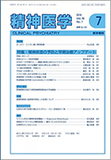Japanese
English
- 有料閲覧
- Abstract 文献概要
- 1ページ目 Look Inside
- 参考文献 Reference
抄録
医療観察法の施行から約10年が経過し,対象者の社会復帰状況には社会的な関心が寄せられている。我々は,保護観察所の協力を得て通院処遇対象者累積402名(794人・年)の主診断,再他害行為,自殺,精神保健福祉法入院,社会資源の活用,就労などを調べた。重大な再他害行為は,低い水準にとどまっていた。一般人口に対する標準化死亡比(SMR)は3.84であった。精神保健福祉法による入院は,退院6か月後27.8%,1年後32.1%で,初回入院の6割は任意入院であった。対象者の9割以上が訪問看護など何らかの地域精神保健サービスを利用していた。約1割の者に就労経験が認められた。本調査結果からは,退院後の地域処遇が効果的に実施されている可能性が示唆された。
Ten years have passed since the Medical Treatment and Supervision (MTS) Act was implemented in 2005. Since then, public interest towards the outcomes of patients who have received treatment and supervision under the law has increased.
We conducted a cohort study of 402 patients who were discharged from designated facilities under community treatment orders. The serious re-offense rate was relatively low, and SMR (standardized mortality ratio) was 384. The readmission rate to community psychiatric hospitals was 27.8% at 6 months and 32.1% at one year. Approximately 60% of first admissions to community hospitals were on a voluntary basis. More than 95% of patients utilized community mental health services in some form, such as nurse visitations and day care programs at hospitals. Of the 402 patients studied, 12% had experienced employed, including part time jobs.
These results suggest that treatment and care in both designated facilities and in communities could be effective in preventing re-offense and promoting reintegration into the society. However, the high level of SMR emphasizes the importance of continued monitoring of patients' physical and mental conditions.

Copyright © 2016, Igaku-Shoin Ltd. All rights reserved.


